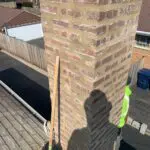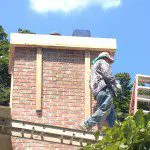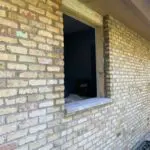05 Oct 2024
Do you need a chimney inspection?

In addition to having the inner workings of your chimney examined, the exterior of the chimney should also be inspected.
Inspect the exterior of your chimney for loose, missing, cracked or damaged flashings — the sheet metal that keeps the intersection between the chimney and roof watertight. These are common sources of problems. Deteriorated flashings should be replaced. If the flashing looks to be in good condition, recaulking should take care of the problem. However, caulk is not a substitute for flashing materials that do not overlap properly.
Also closely inspect the chimney’s brick and mortar joints for signs of wear. Chimneys as well as parapet walls are more exposed to the elements than brick walls so they will be the first to show signs of wear. To avoid major chimney rebuilds make minor chimney repairs as soon as problems arise. Professional chimney repairs will provide peace of mind for the homeowner or business.
Shamrock Tuckpointing has been serving customers in Chicagoland for more than 30 years.
Contact us for a free estimate on chimney repairs, tuckpointing or caulking.

With an average life of 100 years, brick has clear advantage over vinyl which last 50 years, or wood, which lasts 20-25 years. According to the Brick Industry Association, manufacturers have reduced the energy required to manufacturer brick to 1,239 BTU per pound from the approximately 4,000 BTU per pound required in the past.
Very little waste is produced in manufacturing and building because bricks are inherently recyclable. Once water is extracted, a pound of clay material yields almost a pound of brick once water is extracted. During the manufacturing process, any materials that are left over after one run of bricks has been fired can simply be re-mixed into the next run. On the construction site, brick debris can be incorporated into the landscape or used for other projects.
The materials used to manufacture brick are abundant and readily available. The Brick Industry Association reports that most brick is manufactured from materials that are an average of 15 miles away from the plant. There are two or more plants within 500 miles of 49 of the 50 largest metropolitan areas within the United States.
Brick walls are heavy and dense, so they absorb heat and slow down its transfer through the wall. This moderates temperature changes, slowing down heat gain in summer, and storing heat in winter. This is called its ‘lag time’.
Tuckpointing Chicago Brick Buildings
Outside of tuckpointing once every 30 years or so, very little maintenance is required on brick buildings. Shamrock Tuckpointing helps building owners identify problem masonry joints so they can be tuckpointed to keep water from penetrating and deteriorating the brick. During the tuckpointing process, joints are cleaned and new mortar is put in place. This ensures a full 100-year-life.
As a building owner, you can feel confident promoting the green nature of brick. Contact us for tuckpointing and brick repair on your Chicago-area buildings to ensure maximum sustainability.

1) How long have you been in business?
Should you have a question or problem with your job six months or a year from now, you want a company that’s going to be around to answer your call. Hiring your nephew’s friend who has been laid off from his job may save a couple of bucks, but where will he be in a year? It’s also easier to check the references and ratings of a long-standing business vs. someone just picking up a side job.
2) Is your company insured and bonded?
A contractor with employees is required to have workman’s comp insurance to provide coverage in case someone is hurt or injured on the job. If a worker is injured while performing the work on your property and the contractor doesn’t have insurance, you could be financially liable to pay for injuries and rehabilitation.
A bond is an insurance policy that guarantees that the contractor will meet his obligations. If a contractor us unable to complete a job, or performs substandard work, the bonding company would provide payment. Most government agencies only work with bonded contractors. Some bonds are designed to protect you against substandard work that does not meet with local building codes.
3)Can you provide references?
It’s shocking how many people hire a contractor without ever checking references. A contractor should be able to produce a list of customers you can call to ask about the quality of the work, timeliness, and other important factors. Online references or reviews maybe useful, but evaluate them in total rather than getting hung up on one negative review.
4)Who will be on the job site?
It is important to know who is doing the work and what their experience level is. Will the job be subcontracted out to another firm? Who will supervise the job site?
5) What’s the timetable for completing the work?
Weather can sometimes play havoc on tuckpointing schedules, but it’s important to find out how long the job will take and when you can expect it to be completed. You want as little disruption as possible. If you need workers to come in off-peak hours to avoid inconvenience to customers, be sure to let the contractor informed.
6) Do you need a permit for tuckpointing? If so, who will obtain it?
In the city of Chicago, permits are required for most tuckpointing work, and the work must be performed by a licensed masonry contractor. Here’s a list of what types of masonry work don’t require a permit in Chicago. Check with your local municipality to determine the rules for your particular job. Before work begins, ensure that you have all the permits you need to proceed.
Choosing the right contractor doesn’t have to be a a time-consuming chore. If you have your questions organized it should be easy to get the information you need. Click here to learn more about Shamrock Tuckpointing.
11 Sep 2024
When is Lintel Replacement Necessary?

Unfortunately, unless you go to the trouble of having the mortar custom made to match, the repair will stick out like a sore thumb forever. Hire a a professional tuckpointer for a perfect match. Custom mortar is well worth the wait, as it will ensure a seamless repair.
What’s involved in lintel replacement?
The first step is to remove the bricks above the lintel. A replacement lintel should be installed that is galvanized to prevent rust. Proper flashing is also installed. Lastly the brick is reinstalled with weep holes above the flashing, allowing moisture to escape. Contact Shamrock Tuckpointing for an estimate on lintel replacement.

The least expensive repair involves resurfacing the crown. This is only suitable when the crown damage is limited to multiple hairline cracks. We apply a product that seals the masonry, keeping water out and preventing the cracks from deepening. The average cost for resurfacing a chimney crown is $400.
When more extensive damage has been inflicted on the chimney crown, replacement is necessary. To complete the job, the old chimney crown needs to first be removed by chipping out the old mortar. If the damage was severe, brick on the chimney may also need repair.
To create a new crown a form is constructed out of wood to fit the chimney with an overhang to minimize water running down the chimney. Concrete is poured into the form. When the concrete is set, we remove the form. Sealing with asilane-siloxane clear penetrating water repellent on the sides of the chimney as well as the chimney crown help keeps moisture from getting into the chimney. Complete chimney crown replacements range from $1,000 – $4,000 with the cost dependent on how much brick replacement needs to be done. The average cost in Chicago is about $1,000-$3000.
Of course, the best way to find out how much your chimney repair will cost, is to get a free, no obligation estimate. Give us a call today or complete our form. We’ll get back to you soon.



